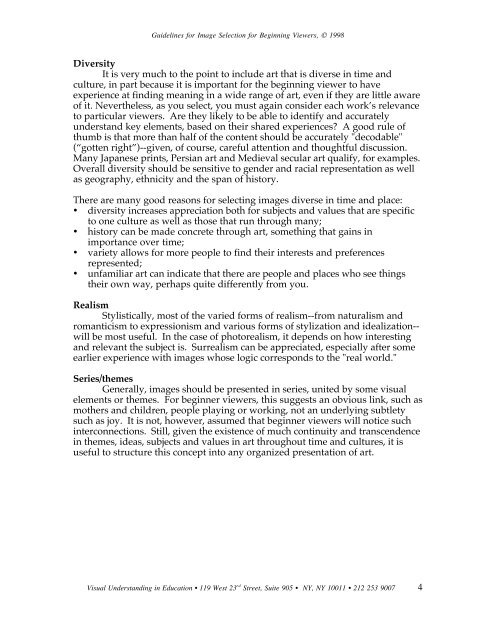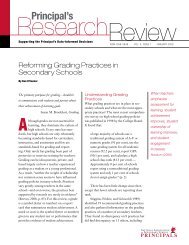Guidelines for Image Selection for Beginning Viewers - eStaffRoom
Guidelines for Image Selection for Beginning Viewers - eStaffRoom
Guidelines for Image Selection for Beginning Viewers - eStaffRoom
Create successful ePaper yourself
Turn your PDF publications into a flip-book with our unique Google optimized e-Paper software.
<strong>Guidelines</strong> <strong>for</strong> <strong>Image</strong> <strong>Selection</strong> <strong>for</strong> <strong>Beginning</strong> <strong>Viewers</strong>, © 1998<br />
Diversity<br />
It is very much to the point to include art that is diverse in time and<br />
culture, in part because it is important <strong>for</strong> the beginning viewer to have<br />
experience at finding meaning in a wide range of art, even if they are little aware<br />
of it. Nevertheless, as you select, you must again consider each work’s relevance<br />
to particular viewers. Are they likely to be able to identify and accurately<br />
understand key elements, based on their shared experiences A good rule of<br />
thumb is that more than half of the content should be accurately "decodable"<br />
(“gotten right”)--given, of course, careful attention and thoughtful discussion.<br />
Many Japanese prints, Persian art and Medieval secular art qualify, <strong>for</strong> examples.<br />
Overall diversity should be sensitive to gender and racial representation as well<br />
as geography, ethnicity and the span of history.<br />
There are many good reasons <strong>for</strong> selecting images diverse in time and place:<br />
• diversity increases appreciation both <strong>for</strong> subjects and values that are specific<br />
to one culture as well as those that run through many;<br />
• history can be made concrete through art, something that gains in<br />
importance over time;<br />
• variety allows <strong>for</strong> more people to find their interests and preferences<br />
represented;<br />
• unfamiliar art can indicate that there are people and places who see things<br />
their own way, perhaps quite differently from you.<br />
Realism<br />
Stylistically, most of the varied <strong>for</strong>ms of realism--from naturalism and<br />
romanticism to expressionism and various <strong>for</strong>ms of stylization and idealization--<br />
will be most useful. In the case of photorealism, it depends on how interesting<br />
and relevant the subject is. Surrealism can be appreciated, especially after some<br />
earlier experience with images whose logic corresponds to the "real world."<br />
Series/themes<br />
Generally, images should be presented in series, united by some visual<br />
elements or themes. For beginner viewers, this suggests an obvious link, such as<br />
mothers and children, people playing or working, not an underlying subtlety<br />
such as joy. It is not, however, assumed that beginner viewers will notice such<br />
interconnections. Still, given the existence of much continuity and transcendence<br />
in themes, ideas, subjects and values in art throughout time and cultures, it is<br />
useful to structure this concept into any organized presentation of art.<br />
Visual Understanding in Education • 119 West 23 rd Street, Suite 905 • NY, NY 10011 • 212 253 9007 4






